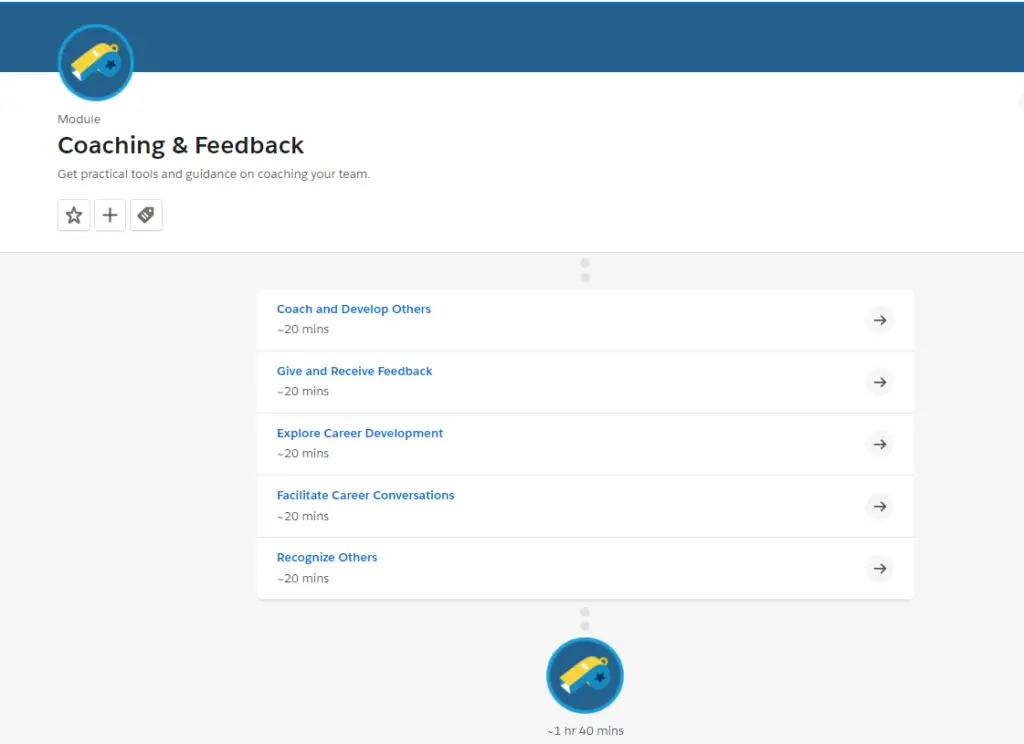In this tutorial, we will see coaching and feedback, coaching and feedback training, coaching and feedback examples, coaching and feedback techniques, and many more.

#1.Coach and Develop Others
Q1)A great coach:
I)Has all the answers
II)Gives advice
III)Asks great questions
IV)Provides instructions
[bg_collapse view=”button-green” color=”#4a4949″ expand_text=”Show Answers” collapse_text=”Hide Answers” ]
II)Gives advice
[/bg_collapse]
Q2)Use a coaching style when:
I)The individual has never done the task before
II)Your employee is stuck and wants to problem-solve
III)The individual needs to know the step-by-step process
IV)You have information the individual needs to do the task
[bg_collapse view=”button-green” color=”#4a4949″ expand_text=”Show Answers” collapse_text=”Hide Answers” ]
II)Your employee is stuck and wants to problem-solve
[/bg_collapse]
Q3)The GROW Coaching Model:
I)Helps employees come up with their own creative ways to solve a problem
II)Uses open-ended questions to analyze the situation and identify next steps
III)Helps employees identify multiple options to overcome a challenge
IV)All of the above
[bg_collapse view=”button-green” color=”#4a4949″ expand_text=”Show Answers” collapse_text=”Hide Answers” ]
IV)All of the above
[/bg_collapse]
#2.Give and Receive Feedback
Q1)Research about feedback shows that:
I)Employees feel that they get enough feedback from their managers
II)Over 75% of employees feel appreciated at work
III)Giving regular feedback engages, retains, and motivates employees
IV)Employees report they won’t work any harder if given more feedback
[bg_collapse view=”button-green” color=”#4a4949″ expand_text=”Show Answers” collapse_text=”Hide Answers” ]
III)Giving regular feedback engages, retains, and motivates employees
[/bg_collapse]
Q2)The purpose of giving feedback is to:
I)Point out to others what they did wrong
II)Help others learn, grow, and be more successful
III)Provide criticism
IV)Comment on what’s not working
[bg_collapse view=”button-green” color=”#4a4949″ expand_text=”Show Answers” collapse_text=”Hide Answers” ]
II)Help others learn, grow, and be more successful
[/bg_collapse]
Q3)An effective approach to giving feedback is to:
I)Compliment someone, share constructive feedback, and end with positive feedback
II)Share the specifics of a situation and explain the behaviors and impact
III)Share your opinion about the issue: “You aren’t a good communicator.”
IV)Keep it high level: “Great job!”
[bg_collapse view=”button-green” color=”#4a4949″ expand_text=”Show Answers” collapse_text=”Hide Answers” ]
II)Share the specifics of a situation and explain the behaviors and impact
[/bg_collapse]
Q4)What works best when interacting with someone who is defensive is to:
I)Ask questions and listen openly to concerns
II)Continue to push forward with your feedback
III)Repeat the message of what’s not working
IV)Take a defensive stance yourself
[bg_collapse view=”button-green” color=”#4a4949″ expand_text=”Show Answers” collapse_text=”Hide Answers” ]
I)Ask questions and listen openly to concerns
[/bg_collapse]
Q5)A good question to ask to get feedback from others is:
I)What am I doing that’s working?
II)What can I do to support you?
III)What can I do more of?
IV)All of the above
[bg_collapse view=”button-green” color=”#4a4949″ expand_text=”Show Answers” collapse_text=”Hide Answers” ]
IV)All of the above
[/bg_collapse]
#3.Explore Career Development
Q1)Career development is:
I)Ensuring your employees get the promotions they deserve
II)Primarily the responsibility of the manager
III)A partnership between an employee, a manager, and the company
IV)Helping employees get the job they want when they want it
[bg_collapse view=”button-green” color=”#4a4949″ expand_text=”Show Answers” collapse_text=”Hide Answers” ]
III)A partnership between an employee, a manager, and the company
[/bg_collapse]
Q2)The manager’s role in career development is to:
I)Advocate for employees when they are ready to move to a new position
II)Match an employee’s skills with new potential opportunities
III)Give feedback to help employees develop
IV)All of the above
[bg_collapse view=”button-green” color=”#4a4949″ expand_text=”Show Answers” collapse_text=”Hide Answers” ]
IV)All of the above
[/bg_collapse]
Q3)The characteristic that most differentiates a Mountain Climber from an Adventure Seeker is:
I)A focus on moving up in the organization
II)Staying in the current job and taking on new challenges
III)Moving to other departments for new experiences
IV)Focusing on becoming an expert in one area
[bg_collapse view=”button-green” color=”#4a4949″ expand_text=”Show Answers” collapse_text=”Hide Answers” ]
I)A focus on moving up in the organization
[/bg_collapse]
Q4)Career development today is:
I)A career ladder focused on upward movement
II)About options that include upward, downward, and lateral career moves
III)A structured career path that maps out each employee’s next step
IV)The sole responsibility of the manager
[bg_collapse view=”button-green” color=”#4a4949″ expand_text=”Show Answers” collapse_text=”Hide Answers” ]
II)About options that include upward, downward, and lateral career moves
[/bg_collapse]
#4.Facilitate Career Conversations
Q1)A career conversation:
I)Should only happen during a performance review
II)Is the chance for the manager to tell the employee what his/her next career step is
III)Can help employees explore different career options
IV)Is only about an employee’s career aspirations, not what the company needs
[bg_collapse view=”button-green” color=”#4a4949″ expand_text=”Show Answers” collapse_text=”Hide Answers” ]
III)Can help employees explore different career options
[/bg_collapse]
Q2)If an employee doesn’t know where he/she wants his/her career to head:
I)Tell him/her what the next step should be
II)Write career goals for him/her
III)Ask questions to explore passions, interests, and strengths
IV)Stop having career conversations until he/she is clear
[bg_collapse view=”button-green” color=”#4a4949″ expand_text=”Show Answers” collapse_text=”Hide Answers” ]
III)Ask questions to explore passions, interests, and strengths
[/bg_collapse]
Q3)Action plans may include:
I)On-the-job experiences
II)Stretch assignments
III)Expanded responsibilities
IV)All of the above
[bg_collapse view=”button-green” color=”#4a4949″ expand_text=”Show Answers” collapse_text=”Hide Answers” ]
IV)All of the above
[/bg_collapse]
Q4)After partnering with your employee to build a career plan, the next step is to:
I)Wait until the annual performance management conversation to check back in on progress
II)Engage in regular quarterly career conversations
III)Take a step back and let your employees run the plan themselves
IV)Take a step forward and make the plan happen for them
[bg_collapse view=”button-green” color=”#4a4949″ expand_text=”Show Answers” collapse_text=”Hide Answers” ]
II)Engage in regular quarterly career conversations
[/bg_collapse]
#5.Recognize Others
Q1)When employees are recognized frequently, they are more likely to:
I)Achieve greater performance and results
II)Leave the organization because they see that they are high performers
III)Stop putting in discretionary effort
IV)Expect to be recognized just for doing their jobs
[bg_collapse view=”button-green” color=”#4a4949″ expand_text=”Show Answers” collapse_text=”Hide Answers” ]
I)Achieve greater performance and results
[/bg_collapse]
Q2)One of the most effective ways to recognize others is to:
I)Give them more money
II)Use the same recognition approach for each person on your team
III)Only recognize significant accomplishments
IV)Tailor recognition to individuals in a way that makes them feel most valued
[bg_collapse view=”button-green” color=”#4a4949″ expand_text=”Show Answers” collapse_text=”Hide Answers” ]
IV)Tailor recognition to individuals in a way that makes them feel most valued
[/bg_collapse]
Q3)You can help your teammates recognize each other by:
I)Being a role model and recognizing the team frequently
II)Setting aside time in meetings to recognize each other
III)Asking your team to develop a fun way to celebrate accomplishments
IV)All of the above
[bg_collapse view=”button-green” color=”#4a4949″ expand_text=”Show Answers” collapse_text=”Hide Answers” ]
IV)All of the above
[/bg_collapse]
Q4)When recognizing others, you should:
I)Only recognize your high performers
II)Only recognize significant accomplishments
III)Find a way to recognize each person on the team
IV)Always recognize them publicly
[bg_collapse view=”button-green” color=”#4a4949″ expand_text=”Show Answers” collapse_text=”Hide Answers” ]
III)Find a way to recognize each person on the team
[/bg_collapse]
coaching and feedback
It’s easy to write a piece of content and send it out into the world, but that’s where most people stop. To really take your content to the next level, you need feedback and coaching.

As a content marketer, you’re often creating your own product. This means that you are in a unique position to find out exactly what your customers want. You can use your audience insights to create better products and more effective campaigns.
coaching and feedback training
Training that focuses on coaching and feedback skills has a direct impact on leadership and business results. These results are achieved by identifying the development needs of others, seeing the world from the perspective of those they lead, and listening to understand versus listening to respond.
The reason this training is so important is that it’s a foundational skill for anyone in a management position. Training in coaching and feedback improves leadership performance and creates more engaged employees. It also helps organizations achieve their goals.
coaching and feedback examples
Any feedback can be positive feedback, but coaching is a specific type of feedback that is intentionally designed to help with development. The four elements of coaching include:
- #1 No judgment, just fact
- #2 No advice, just information
- #3 No solutions, just suggestions
- #4 No change, just understanding
coaching and feedback techniques
Many of us are using coaching and feedback techniques that are outdated. While they may have been effective in the past, they have become obsolete in the modern world. So I’m going to share with you three techniques that will help you coach and give feedback more effectively.
The first technique is to be more specific. When you give feedback, try to describe exactly what the person did that was good or bad. When you give broad feedback like “you should keep practicing”, it doesn’t help the person improve. Instead, tell them exactly how they could do better next time, like“try using your non-dominant hand to do the exercise”.
The second technique is to be more positive. If you want to give feedback, make sure it’s about what the person did right, not what they did wrong. This is called “positive feedback”.When you tell someone what they did wrong, it can make them feel bad about themselves and make them less likely to want to do the exercise again. Instead, try saying something like “you’re doing great! Keep it up!”
The third technique is to be more specific and positive. This means that you should give both positive and negative feedback, but the negative feedback should be about things that can be improved, not things that are wrong. The reason for this is that it’s very easy to feel criticized when you receive negative feedback, and the result is that you get defensive and don’t hear what the other person is saying.
Learn More:
- General Course: Blockchain Basics, Bitcoin, Cryptocurrency, Technology
- General Courses: Culture Of Feedback, Types, Benefit, Important
- General Courses: Cyber Resilience
- General Courses: Demo Storytelling
- General Course: Digital Banking Basics-MPS
- General Courses: Demo Delivery Essentials
- General Courses: Google Analytics Basics
- General Courses: Great Management
- Module: Custom Metadata Types Basics
- Module: Apex Metadata API
- Module: Git And GitHub Basics
- Module: Strategies For Big Data Architecture
- Module: Heroku Architecture Designer Certification Maintenance